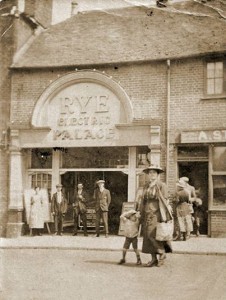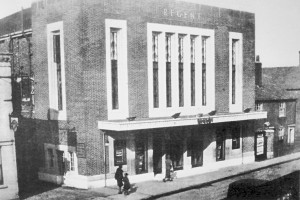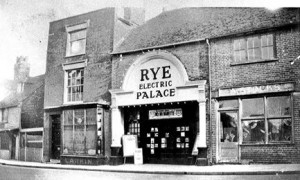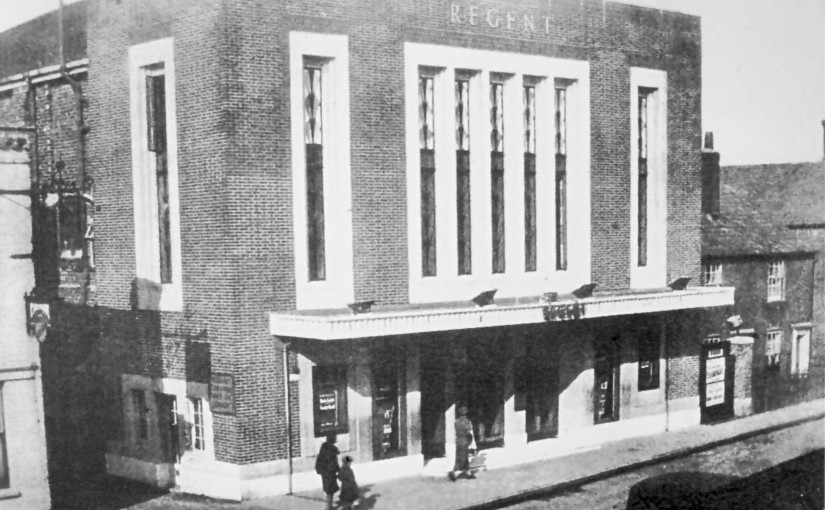Many of these ‘Memories’ came from Jo’ Kirkham’s “Memories” series.
We were given the first mention of a theatre by Mrs M. Allen. She
described Mr. John West’s visiting ” Rye Theatre”. This was a canvas
structure erected on Crown Field, before World War 1. it had a fresh
production every night, but soon closed for lack of funds.
The “Bijou Theatre”, or “Cinque Ports Assembly Rooms”, or the “Pavillion”.
This was attached to the old Cinque Ports Hotel where the present
Police Station has now been built.
It was a “long, narrow shed like building”.(Mrs. D. Breeds) Amateur
Musicals, Talent Shows, Gilbert and Sullivan Operettas, and Children’s
Shows, were regularly held. Mrs N. Jones remembers her sister doing
the Charleston to win a prize. It was the venue for visiting Variey
Shows.
On November 9th 1910, the first licence for a performance of a “Cinematograph
Exhibition”, in Rye, was issued for these premises. However it still
seems to have concentrated on Stage Shows. The Bijou had every thing
from “Maria Marten” to ballet”.(Mrs. Embleton)
“I remember Mermaid Street School Concerts being held there, when
I was in Miss Moon’s class. In one, I played Father Christmas and
had to stop a fight which St. George, (Clem Oliver) was having. In
another, a dozen of us were carol singers, and we went through the
audience with a stick held over our shoulders. Tied to the end of
the stick was a jam jar containing a lighted candle”.(Mr. Les Paine)
“Travelling players gave shows there.” (Mrs. B. Pope)
Mr.Sanderson organised the lighting, all by gas in those days, for
many of the shows. “I remember one incident, when the Manager was
missing when the wages were due to be paid. The cast were out on the
pavement, and told us about the fact that he had run off with their
wages. We all went searching for him – it seemed that he had got out
of the window to make his escape! We threw stones under the rail trucks
loaded with coal, to try to flush him out. Eventually he was found,
hiding under the seat on the platform, on the “up-side”, waiting to
get the London train. This must of been about 1925.”
“The Monastery” Upper Room served as a theatre for many years, as
one of its many uses. The Grammar school pupils were taken by Miss
Turner to see the Jaquard Puppet Show there on 13th June 1936.

“The Electric Palace”, Landgate, was the first real cinema. (It is
now Bateman and Maxfield Ltd.) The front “originally had a set of
small glass paned folding doors, opening up into a foyer. My last
memory, as a small child was the scented smell of the interior. I
know now that it was a form of air freshening, given by a cylinder
which was carried round giving off a fine pressure spray. Over the
entrance was a large arc of relief plaster-work, with electric light
bulbs in block capital letters, saying “ELECTRIC PALACE”. The building
had its own generator to produce electricity, in a rear building.
It was not uncommon for the lights to begin to fail when a fault occured.”
(Mr. C Bloomfield).
“The Picture Palace……….was run by Mr. Hackman, who played the
piano, and shouted at the children to be quiet They were silent films!“(Mr.
K Gasson)
We called it “The Flea Pit”. When you shook the curtain at the back,
clouds of dust came out”.(Mrs. Rhodes).
It was called the “Flea Pit ” as one always took one home!”.(Mrs.
Brett)
“I remember seeing ‘Ben Hur’ .“(Mrs. Pennington).
Almost every contributer spoke of visits to this cinema- as children
attended, often on Saturday afternoons, and usually in the cheapest
seats. The cost was 2 1/2d, 4d, 8d, or 1/-.
“The shows were changed twice a week, except when the film was considered
important enough to justify a six day showing.“(Mr. J. D. Smith).
“I remember I had to do jobs for my mother to earn the 4d to go to
the cinema on Saturday afternoon.
I had to chop wood or bring a load of potatoes from our allotment
along South Undercliff, in a Tate and Lyle box on wheels. Another
job could be to take the shoots off a bag of potatoes in the cellar.
I often had to take a tray of buns to be cooked at the coal-fired
bakehouse on Longley’s Corner, on the way to the cinema, and collect
them, baked, on the way home.

Mr Axell acted as a pianist and manager; Miss Axell was the usherette,
in a uniform, selling sweets; and Miss Walker was the cashier. Peter
Cook looked after the engines which produced electricity. (there was
no main electricity then in Rye.) [We imagined the impact on quite
a dark town, of this “blaze” of light!] If the machines broke down,
and the lights went out, it was best not to try to leave, or else
you could have banana skins thrown at you! (Mr. Les. Paine).
I recall “Tom Mix”! The films came from Tenterden, and I went to see
them twice a week“ recalls Mrs. B. Pope.
I remember going to see a Black and White film of the “Brotherhood
and Guestling”, a Cinque Ports meeting which my father had just attended
as Mayor of Rye, in 1925.” (Miss E. Harvey)
L.A.Vidler states at a Council Meeting in October 1914,- “Mr Pollard
offered a cinematograph performance in aid of the “Rye Patriotic War
Fund”.
“The Landgate Cinema Became so popular with ‘Talkies’, and then “Technicolour
Films”, that larger premises were needed.
Messrs. Shipman and King bought the ‘Bijou’ and demolished it in 1931.”
(Mr. A Woodgate)
In its place they built the first ‘Regent’, which was officially opened
by Lady Maude Warrender in 1932.” (Miss Welfare).
“It was built to the highest standards and the cost of seats reflected
this being 1/-, 2/-, and 2/6d.” (Mr. D. Breeds).
“Good films would always create a queue for the next showing. Saturday
afternoons attracted very many children.“(Mr. Les. Paine).
The Rye Players used this cinema for some of their productions, and
these were a major feature of Rye life in the 1930’s. Sadly,it was
bombed during lunchtime, with one bomb going through the roof, and
blowing the structure apart, on September 22nd 1942” (Mr. C. Bloomfield).
“The film showing at the time was,’Gone With The Wind’!”(Mrs. Y Cotterell)
[Gone with the Wind was not showing at the time of the bombing but
a soldier wrote ‘Gone with the Wind’ on the facia of the shattered
cinema. Editor]
During the war, the “Electric Palace” was re-opened, and films were
also shown at the “Monastery”, for the entertainment of the many troops
stationed in the area, as well as the remaining local people.

“Many people in the 1930’s, and during World War 11, would take the
bus service 112 to Hastings, not only to shop, but to see films. It
cost 2/- (10p) return“(Mr. Les. Paine).
The second “Regent”, was built on the site of the first, in 1948,
in nine months. 2I believe it was the first to be built in England
after World War Two”.(Miss Welfare).
“Rye’s Own” April 2002
All articles, photographs and drawings on this web site are World
Copyright Protected. No reproduction for publication without prior
arrangement.
© World Copyright 2015 Cinque Ports Magazines Rye Ltd., Guinea Hall
Lodge Sellindge TN25 6EG
